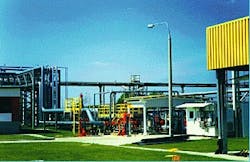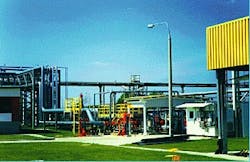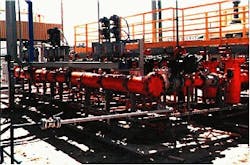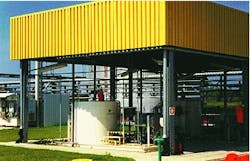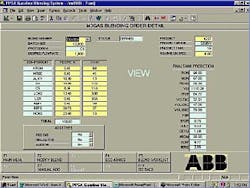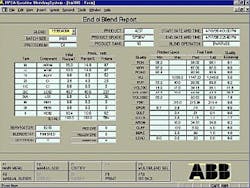New gasoline-blending unit started at Poland refining
In 1996, Petrochemia Plock SA (PPSA) built a new gasoline-blending unit (GBU) in its Poland refining complex to automate and upgrade its gasoline-blending facilities.
Today, advanced blending control saves the refinery about $3-4 million/year.
The project was part of a larger PPSA modernization and development effort to make products that met or exceeded EU future 2005 specifications. The larger effort was spurred by Poland`s preparation for membership to the European Union (EU) and the North Atlantic Treaty Organization (NATO).
The GBU plant produces up to 4 million metric tons/year (mty) of four basic gasolines: base 94, base 98, Eurosuper 95, and super plus 98.
PPSA owns the largest refining complex in Eastern Europe, which has a capacity of 12.6 million mty of crude.
Scope of GBU
The GBU project had several parts besides the sophisticated automatic blending control and optimization system for gasoline. It also included the modernization of the tank farm and the addition of new pipelines, new motor-operated valves, 23 component pumps, a new in-line blender skid, two dye and additive injection skids, and a near infra-red on-line analyzer.
Fig. 1 shows the new GBU.
The automatic blending control and optimization system provides a complete management system for blending operations. It has several functions:
- Generation of blending orders (date/times, recipes, tanks, and quantities)
- Automatic interface to the planner
- Automatic conversion of the blending order into an executable blending task with automatic field-equipment path selection
- Automatic line-up, start-up, control and monitoring, and shut-down
- End-of-blend reporting.
The GBU project started in November 1996. Field-equipment installation started in December 1997, and start-up occurred in June 1998.
The final site acceptance test (SAT) took place in November 1998. SAT results met or exceeded the requirements for throughput and quality. The design specified a throughput rate of 1,000 cu m/hr, and actual performance was 10% greater, or 1,100 cu m/hr. The octane quality specification was -0, +0.25 research octane number (RON) at 3 sigma 95% confidence limit, and the actual results were -0, +0.184 RON.
The project involved many companies, and required a great deal of coordination.
GBU components
ABB provided a turnkey solution for PPSA`s GBU modernization project. The solution included the blend technology software, a distributed control system (DCS), field equipment, and engineering services.
The solution was based on ABB`s process knowledge and experience. ABB`s blending engineers have been involved with computer control of blending since the 1960s.
PPSA required that the project be implemented within 18 months. ABB managed the design and construction under the constraints of this turnaround time and the need to avoid impacting the existing gasoline-blending operation.
To minimize field-construction problems, the process equipment was designed and fabricated in the form of prewired and pretested skids. After factory acceptance testing, the skids were broken up and flown to Poland. This procedure permitted rapid erection and start-up of the equipment.
The blender skids consisted of four sections that were bolted together on-site on a concrete pad. They were completely prewired and tested, ready to start-up and commission.
Fig. 2 shows the installed blender skids.
The dye and additive system consisted of two (red and yellow) dye-dilution and injection skids. These skids included the dye tanks (Fig. 3).
The on-line analyzer measured eight properties: RON, motor octane number (MON), Rvp, E70 (percentage of fuel evaporated at 70° F.), E100, E180, final boiling point, and density.
In search of a reliable, low life-cycle-cost analyzer, ABB decided to use a no moving parts, near infrared (NIR) multiproperty analyzer. The analyzer was chosen based on ABB`s prior experience with it. The alternative was eight separate analyzers, each requiring its own installation, sampling system, calibration, maintenance, and support.
The NIR analyzer was mounted in a pressurized shelter and connected to the blender header and to six protofuel tanks, which hold certified fuel. The NIR-analyzer system automatically checks its calibration before every new blend using the certified fuel in these tanks.
The 23 component pumps were distributed on four pads. An automatic spillback design provides minimum flow bypass and protects the pumps during the blend start-up and shutdown sequence. The DCS software monitors the pump-seal leak alarms, winding temperature, and oil loss.
All the pumps and remotely operated valves have local, remote control switches. Positive status indications are conveyed by limit switches and current readings. All these signals are connected to the DCS for automatic remote control by the blending software.
Automatic blending
The new automatic blending-control system has advanced work-order management capabilities. The system also has automatic path selection and automatic line-up functions, start-up and shutdown sequence control, basic regulatory blending control, and extensive reporting capabilities.
Blend start-up is made more efficient by minimizing the need for data entry by the operator. During start-up, the system uses a blend work-order library and default data, or inferred data.
The automatic blending control programs provide for automatic manipulation of field equipment in conjunction with blend start-up and blend shutdown operations.
The automatic blending control reporting and blend-order management capabilities provide a cost-effective solution to the need for more extensive blend management and record-keeping. Because it extensively uses open software components and the widely used Oracle relational database, it forms a solid foundation for a plant information and offsites tank-farm resource-management system.
The automatic blending-control functionality can be expanded from gasoline blending to diesel, fuel oil, and lube-oil blending.
Automatic blending control has several advantages. It:
- Maximizes the use of tank-farm equipment (such as tanks, blenders, pumps, lines, and berths), which, in effect, increases refinery throughput with no additional capital investment
- Minimizes tank inventory and capital costs tied into the inventory
- Reduces off-specification product
- Reduces product-quality giveaway
- Minimizes product-transfer errors
- Reduces product losses
- Reduces equipment damage through early problem detection and avoidance
- Reduces offsites and laboratory manpower workload
- Facilitates compliance with government safety and reporting requirements
- Integrates laboratory and refinery information systems via a network
- Has a low life-cycle cost.
Depending on current refinery economics, typical benefits of using the advanced-blending control software are in the order of $0.30-0.90/cu m. For PPSA`s 4 million mty production, the benefits are of the order of $3-4 million/year.
Standard features
The ABB blend technology uses nonlinear programs both as a multivariable constraint controller and as an on-line optimizer.
The software runs on client-server platforms with open technology and industry standards such as ODBC (open database connectivity), DCOM (distributed component object model), TCP/IP (transport control protocol/internet protocol), Windows NT, and Oracle.
Standard features of ABB`s blend technology include:
Specific user dialogues address the different needs of planners, laboratory technicians, operators, and blend engineers for information, access, and control.
Users can easily select blend-work orders, execute path selection and line-ups, control blend stages (such as start, stop, suspend, and resume), monitor the blend-control performance, and display and print reports.
The blending engineer`s environment supports complete facilities for modifying the process piping topology, adding or modifying control strategies, property correlations, or the cost/price database, editing of blending optimizer equations. The system also has debugging tools.
All environments (for the planner, laboratory technician, operator, and blending engineer) are menu-driven and provide convenient, ready access to the system.
The main purpose of the planner is to optimize component inventory utilization over the 4-week interval. Blend orders are automatically created by the planner by simple "point and click" motions.
Each blend order includes the initial optimal recipe, the component and product tank to use, the batch size, the product grade, and the approximate start date and time.
To make it easy and minimize data entry requirements, typical defaults are used. The work orders are archived on-line for later use in reports and other document generation.
Fig. 4 shows a sample screen of the work-order status list.
The operator can select a blend order from the list to see its details. From that screen, the operator can select the blend for execution, if desired.
This feature also checks that the on-line analyzers pass a validation check with protofuels and an on-line validation against a calculated prediction. It also turns on the product-tank quality integration algorithm, which is the basis for integrated tank quality control by the on-line optimizer.
This application also checks, via an "auto-pilot" feature, that all the conditions are met before turning on the on-line optimizer.
A "data entry" display is available for plants without an LIMS (laboratory information management system). This allows for manually entering of laboratory analysis data by a technician.
A screenshot of a sample end-of-blend report is shown in Fig. 4.
Standards and engineers
To keep project costs low, customers need to maximize the reuse of existing technology, whether that is standardized blender skids, additive-injection systems, prepackaged on-line analyzer systems, or standardized software.
Although standardization still leaves a fair amount to customization, it can mean the difference between a 0% or 40% reuse factor. This factor affects price, delivery time, installation, documentation, and support.
Part of the standard solution was the availability of experienced PPSA and ABB engineers to support the project. The engineers were knowledgeable in tank farm automation technology. Their services included tank-farm process design, basic and detailed engineering, procurement of DCS, analyzers, and skids, installation, start-up, and commissioning.
For the software, engineers were needed for functional design customization, detail design, software customization implementation, staging and testing, user training, documentation, and start-up.
Acknowledgments
We would like to acknowledge the contribution of the PPSA and ABB project teams. K. Kozera, B. Slavinski, R. Truszczynski, J. Tomaszewski, H. Krzanowski, P. Shah, B. Krass, and many others contributed to the success of the project.
The Authors
Andrzej Popkowski is vice-manager of the fuel-production complex at the Petrochemia Plock SA refinery, where he is responsible for the distillation, cracking, and blending complexes.
Popkowski has more than 30 years` refining experience. He holds an MS in chemical engineering from Lodz Polytechnic Institute.
Ara Barsamian works for Refinery Automation Institute LLC. Previously, he was the director of the oil and gas business development group for ABB Industrial Systems Inc. He has more than 30 years` experience with ABB, 3X Corp., and Exxon Research & Engineering Co., where he designed, implemented, and started up numerous advanced process control, blending, oil movements, and refinery information systems.
At Exxon, Barsamian headed the digital control group responsible for developing state-of-the-art DCS and advanced process control computers cooperatively with major vendors. He also did pioneering work on the on oil movements and storage and blending automation.
He holds BS and MS degrees in electrical engineering from City University of New York.
